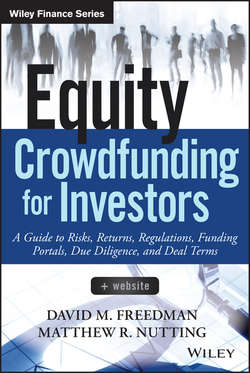Читать книгу Equity Crowdfunding for Investors - Matthew R. Nutting - Страница 20
На сайте Литреса книга снята с продажи.
Chapter 1
The Foundations of Online CrowdfundingA History of Rewards-, Donation-, and Debt-Based Crowdfunding Platforms
Debt and Donation Crowdfunding
ОглавлениеBefore we introduce the equity-based version, it is worth looking at two more types of large-scale crowdfunding platforms that preceded equity-based crowdfunding in the United States: debt-based and donation-based.
Debt-based (or what in the United Kingdom is called “lending-based”) crowdfunding began at the nonprofit level in 2005, when Kiva Microfunds was launched by Matt Flannery, a software programmer in San Francisco, and Jessica Jackley, who had worked for a microfinance institution in Africa. Kiva is now the fourth-biggest crowdfunding site in the world in terms of traffic, as measured by Alexa (a website information, analytics, and ranking service).
Flannery and Jackley, a married couple, call their business model “person-to-person microfinance.” The Kiva website features individuals in the “developing world,” some of them impoverished, who apply for unsecured loans to build or grow small businesses, ranging from amounts as small as $25. In the beginning, Kiva featured only overseas borrowers, especially in Africa and Latin America. In 2009 it broadened its scope to include borrowers in U.S. and Canadian communities that are underserved by banks and traditional lenders, and in 2012 it introduced student loans (in a partnership with Strathmore University in Kenya). Kiva also serves borrowers in the Middle East, Southeast Asia, and India.
Конец ознакомительного фрагмента. Купить книгу
